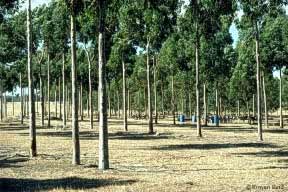|
|
|
Forestry for economic diversification

Farm forestry offers Australian farmers
an opportunity to build income security without threatening
conventional agriculture production by investing in forestry
on the less productive parts their farms. Agricultural returns
are susceptible to poor seasons and fluctuating markets. Timber,
seed and other tree products commonly have markets unrelated
to agricultural commodities such as wool or beef. Some tree
products—for example, timber—also remain available
for harvest even through poor seasons.
Forestry might also offer farmers taxation, superannuation
and generational transfer options and benefits. By investing
in a long-term venture that will mature well into the future,
farmers may be able to cater for their own retirement without
drawing resources from their children's agricultural enterprise.
Farm forestry is a long-term, and sometimes risky, investment.
So a thorough diagnosis of the farm's business situation,
and the family's investment objectives, is required before
a commitment is made to establish a forest farm. Projects
must reflect individual farmers’ circumstances and their
willingness to commit resources and time to a long-term investment.
The best design is the one that matches the farmer's individual
performance criteria without exposing them to an uncomfortable
level of risk.
Back to top
 |
|
|
|
